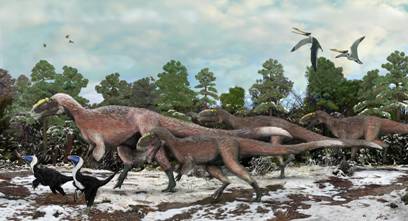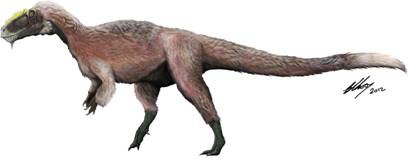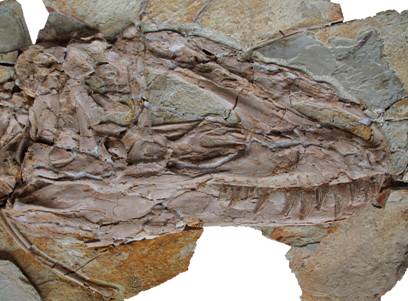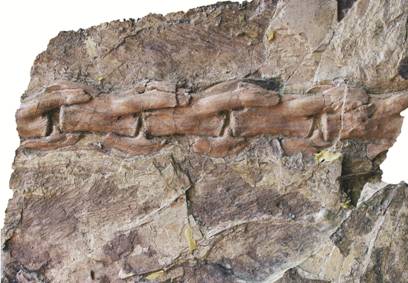| Location: Home > Research > Research Progress |
| Newly Discovered Close Relative of T. Rex Is Largest Known Feathered Dinosaur |
|
Palaeontologists have known for more than a decade that some small dinosaurs had bird-like feathers, mainly thanks to beautifully preserved fossils from northeastern China. Now three specimens of a new tyrannosauroid from the same region show that at least one much larger dinosaur had a feathery coat as well. The name of the new species, Yutyrannus huali, means “beautiful feathered tyrant” in a combination of Latin and Mandarin. The three specimens were collected from a single quarry in Cretaceous beds in Liaoning Province, and are described by Chinese and Canadian scientists in this week’s issue of the journal Nature. “The feathers of Yutyrannus were simple filaments,” explained Professor Xu Xing of Beijing’s Institute of Vertebrate Paleontology and Paleoanthropology, the lead author of the study. “They were more like the fuzzy down of a modern baby chick than the stiff plumes of an adult bird.” The researchers estimate that an adult Yutyrannus would have been about 9 metres long and weighed about 1400 kg, making it considerably smaller than its infamous relative Tyrannosaurus rex but some 40 times the weight of the largest previously known feathered dinosaur, Beipiaosaurus. The large size of Yutyrannus and the downy structure of its feathers would have made flight an impossibility, but the feathers may have had another important function – insulation. “The idea that primitive feathers could have been for insulation rather than flight has been around for a long time,” said Dr Corwin Sullivan, a Canadian palaeontologist involved in the study. “However, large-bodied animals typically can retain heat quite easily, and actually have more of a potential problem with overheating. That makes Yutyrannus, which is large and downright shaggy, a bit of a surprise.” The explanation may be climate-related, the researchers say. While the Cretaceous Period was generally very warm, Yutyrannus lived during the middle part of the Early Cretaceous, when temperatures are thought to have been somewhat cooler. The gigantic T. rex and its closest relatives, by contrast, lived in the warm conditions of the Late Cretaceous. Isolated patches of preserved skin from these animals show scales, not feathers, but the possibility that even they were partly feathered cannot be completely ruled out. “Yutyrannus dramatically increases the size range of dinosaurs for which we have definite evidence of feathers,” Professor Xu said. “It’s possible that feathers were much more widespread, at least among the meat-eating dinosaurs, than most scientists would have guessed even a few years ago.”
Fig.1: Artist’s impression of a group of Yutyrannus and two individuals of the smaller Beipiaosaurus. Artwork may be used freely to accompany an article on this new animal, but should be credited to Dr Brian Choo and future requests for use should be directed to him. A high resolution version of the image is available from Dr Sullivan (contact details below).
Fig.2: Artist’s impression of an individual Yutyrannus. Artwork may be used freely to accompany an article on this new animal, but should be credited to Dr Brian Choo and future requests for use should be directed to him.
Fig.3: Skull of Yutyrannus. Photo may be used freely to accompany an article on this new animal, but should be credited to Mr Zang Hailong. Future requests for use should be directed to Prof. Xu Xing.
Fig.4: Part of the tail of Yutyrannus, showing preserved filament-like feathers. Photo may be used freely to accompany an article on this new animal, but should be credited to Mr Zang Hailong. Future requests for use should be directed to Prof. Xu Xing. For further details of the research or higher-resolution versions of any of the above images, or to arrange an interview with any of the authors, please contact Dr Corwin Sullivan: Email: csullivan@ivpp.ac.cn Phone: +86 136-2132-4250 Please note that most members of the research team are based in China (GMT +8 hours) and thus are often not available during normal office hours in Europe and North America. |



